Sie möchten einen sicheren Ort, an dem Sie mit Ihrer WordPress-Website experimentieren können, ohne Angst haben zu müssen, etwas auf Ihrer Live-Site kaputt zu machen?
Das Verschieben Ihrer WordPress-Site auf einen lokalen Server auf Ihrem Computer ist unserer Meinung nach die perfekte Lösung, insbesondere für Entwickler, Designer oder WordPress-Anfänger.
Die Installation von WordPress auf Ihrem Computer (lokaler Server) ermöglicht es Ihnen, WordPress einfach zu erlernen und Dinge zu testen. Wenn Sie eine Live-WordPress-Site auf einen lokalen Server verschieben, können Sie mit denselben Daten experimentieren wie mit Ihrer Live-Site.
In diesem Artikel zeigen wir Ihnen, wie Sie eine Live-WordPress-Site ganz einfach auf einen lokalen Server verschieben können.
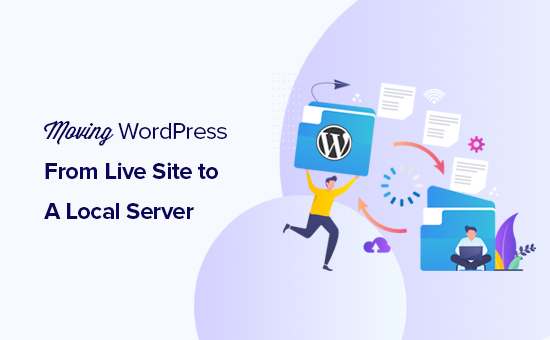
Warum und für wen ist es sinnvoll, eine WordPress-Website auf einen lokalen Server zu verschieben?
Wenn Sie bereits seit einiger Zeit eine WordPress-Website betreiben, möchten Sie vielleicht neue Themes oder ein Plugin ausprobieren. Wenn Sie dies jedoch auf einer Live-Website tun, kann dies zu einer schlechten Benutzererfahrung für Ihre Benutzer führen.
Um dies zu vermeiden, erstellen viele Benutzer eine Kopie ihrer WordPress-Website auf einem lokalen Server, um neue Themes und Plugins zu testen oder Entwicklungstests durchzuführen.
So können Sie Ihr Thema mit all Ihren Inhalten einrichten und alle Funktionen testen, ohne sich Sorgen machen zu müssen, dass Ihre Website kaputt geht. Viele Benutzer kopieren ihre Website auf einen lokalen Server, um ihre WordPress- und Programmierkenntnisse mit echten Website-Daten zu üben.
Auch wenn Sie alle Tests mit Dummy-Inhalten in WordPress durchführen können, geben Ihnen die Daten einer echten Website eine bessere Vorstellung davon, wie diese Änderungen auf Ihrer Live-Site aussehen werden.
Vorbereiten der Verschiebung einer lokalen Site auf einen lokalen Server
Zunächst müssen Sie sicherstellen, dass Sie immer ein Backup Ihrer WordPress-Website erstellen. Es gibt mehrere großartige WordPress-Backup-Plugins, die Sie verwenden können.
Zweitens müssen Sie eine lokale Serverumgebung auf Ihrem Computer installieren. Sie können WAMP für Windows und MAMP für Mac verwenden. Sobald Sie die Umgebung eingerichtet haben, müssen Sie mit phpMyAdmin eine neue Datenbank erstellen.
Rufen Sie einfach die folgende URL in Ihrem Browser auf, um phpMyAdmin zu starten.
http://localhost/phpmyadmin/
http://localhost:8080/phpmyadmin/
Hier müssen Sie auf die Registerkarte „Datenbanken“ klicken und eine neue Datenbank erstellen. Diese Datenbank benötigen Sie später, um Ihre Live-Site-Daten zu entpacken.
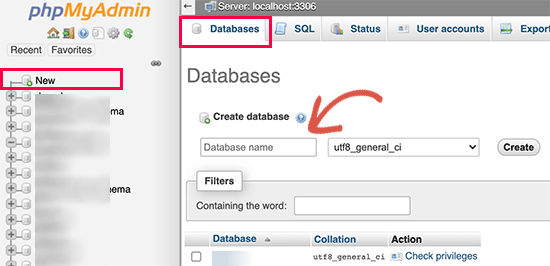
Sie sind nun bereit, Ihre Live-WordPress-Site auf einen lokalen Server zu verschieben.
Methode 1. Verschieben einer Live-WordPress-Site auf einen lokalen Server mit einem Plugin
Diese Methode ist einfacher und wird für alle Benutzer empfohlen.
Als Erstes müssen Sie das Duplicator-Plugin installieren und aktivieren. Weitere Details finden Sie in unserer Schritt-für-Schritt-Anleitung für die Installation eines WordPress-Plugins.
Mit Duplicator können Sie ganz einfach ein Duplikatpaket Ihrer gesamten Website erstellen. Es kann verwendet werden, um Ihre WordPress-Website an einen neuen Standort zu verschieben, und kann auch als Backup-Plugin verwendet werden.
Hinweis: Es gibt eine kostenlose Version von Duplicator, mit der Sie loslegen können. Duplicator Pro bietet jedoch unbegrenzte Backups und erweiterte Funktionen.
Nach der Aktivierung gehen Sie in Ihrer WordPress-Admin-Seitenleiste auf Duplicator Pro “ Backups. Um ein neues Paket zu erstellen, müssen Sie auf die Schaltfläche „Neu hinzufügen“ klicken.
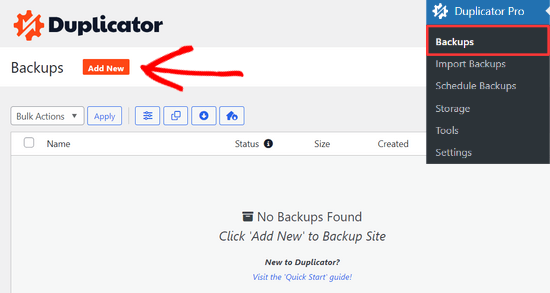
Duplicator startet dann den Sicherungsassistenten.
Zunächst müssen Sie einen Namen für Ihr Sicherungspaket eingeben. Sie können auch die dynamischen Tags verwenden, um automatisch ein Namensformat wie das Datum und den Titel Ihrer Website zu erstellen.

Erweitern Sie dann den Abschnitt „Speicher“ und wählen Sie einen Speicherort.
Für dieses Lernprogramm verwenden wir den Standardspeicherort. Sie können auf den Link „Speicher hinzufügen“ klicken, um einen neuen Speicherort hinzuzufügen, z. B. Dropbox oder Google Drive, wenn Sie möchten.
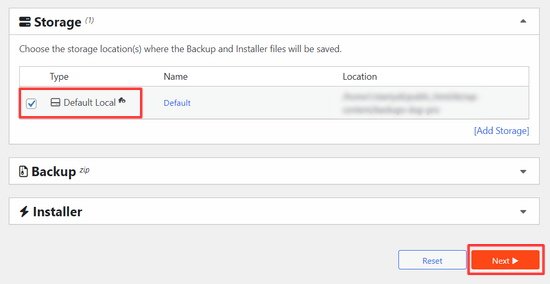
Klicken Sie auf die Schaltfläche „Weiter“, um fortzufahren.
Das Plugin scannt dann Ihre Website und führt einige Hintergrundprüfungen durch. Es zeigt Ihnen dann eine Zusammenfassung dieser Überprüfungen.
Wenn alles gut aussieht, klicken Sie auf die Schaltfläche„Sicherung erstellen„, um fortzufahren.
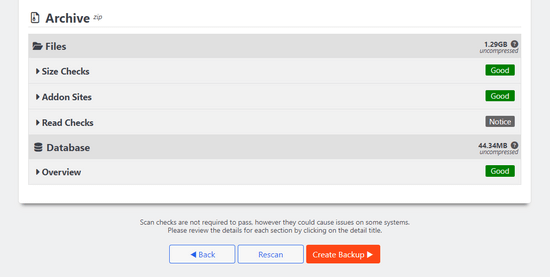
Duplicator wird nun Ihr Website-Paket erstellen.
Danach sehen Sie eine Zip-Datei, die alle Daten Ihrer Website enthält, und eine Installationsdatei. Sie müssen beide Dateien auf Ihren Computer herunterladen.
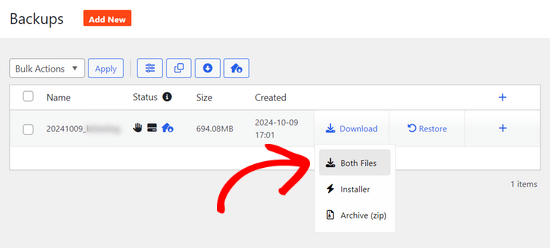
Jetzt können Sie diese Dateien entpacken und auf Ihrem lokalen Server installieren.
Zunächst müssen Sie einen neuen Ordner im Stammverzeichnis Ihres lokalen Servers erstellen. Dies ist der Ordner, in dem Ihr lokaler Server alle Websites speichert.
Wenn Sie zum Beispiel MAMP verwenden, ist es der Ordner /Applications/MAMP/htdocs/. Wenn Sie jedoch WAMP verwenden, ist es der Ordner C:\wamp\www\.
Innerhalb dieses Ordners können Sie für jede neue Website, die Sie importieren oder auf Ihrem lokalen Server erstellen möchten, neue Ordner anlegen.
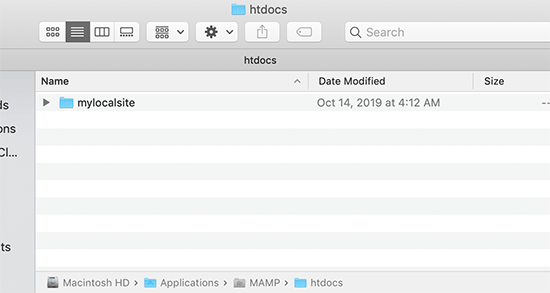
Danach müssen Sie den Ordner öffnen, den Sie für Ihre lokale Website erstellt haben, und dann sowohl die Archiv-Zip-Datei als auch das Installations-Skript, das Sie zuvor heruntergeladen haben, kopieren und einfügen.
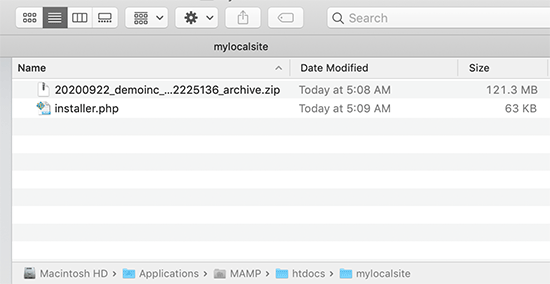
Um die Installation durchzuführen, müssen Sie das Skript installer.php in Ihrem Webbrowser öffnen.
Wenn Sie zum Beispiel beide Dateien in den Ordner /mylocalsite/ eingefügt haben, können Sie sie in Ihrem Browser unter http://localhost/mylocalsite/installer.php aufrufen .
Das Duplicator-Installationsskript sieht nun wie folgt aus:
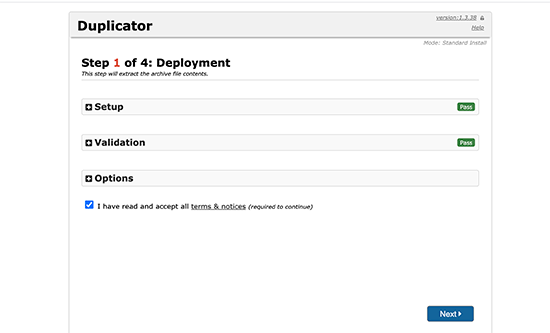
Klicken Sie auf die Schaltfläche „Weiter“, um fortzufahren.
Duplicator entpackt nun die Archiv-Zip-Datei und fordert Sie auf, die Datenbankinformationen Ihrer lokalen Website einzugeben. Dies ist die Datenbank, die Sie zuvor erstellt haben.
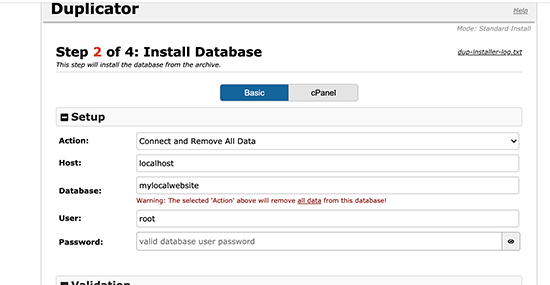
Der Servername ist fast immer localhost und der Benutzername ist root. In den meisten Fällen hat Ihre lokale Serverinstallation kein Passwort für root festgelegt, so dass Sie dieses leer lassen können.
Unten auf der Seite finden Sie eine Schaltfläche „Datenbank testen“, mit der Sie sicherstellen können, dass Ihre Datenbankinformationen korrekt sind.
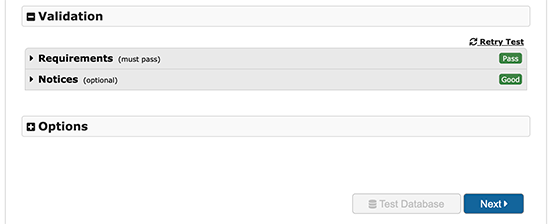
Wenn alles gut aussieht, klicken Sie auf die Schaltfläche „Weiter“, um fortzufahren.
Duplicator wird nun Ihre WordPress-Datenbank importieren. Danach werden Sie aufgefordert, die neuen Website-Informationen, die automatisch erkannt wurden, zu überprüfen.
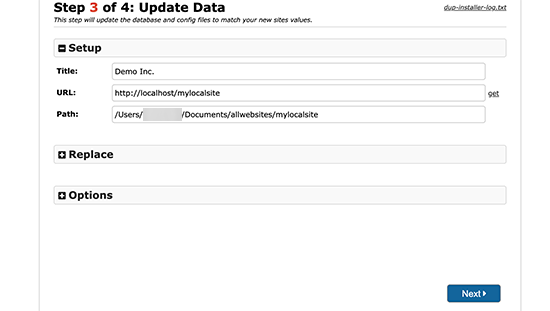
Klicken Sie auf die Schaltfläche „Weiter“, um fortzufahren.
Duplicator beendet nun die Einrichtung und zeigt Ihnen eine Schaltfläche an, mit der Sie sich bei Ihrer lokalen Website anmelden können. Sie verwenden denselben WordPress-Benutzernamen und dasselbe Passwort, das Sie auf Ihrer Live-Site verwenden.
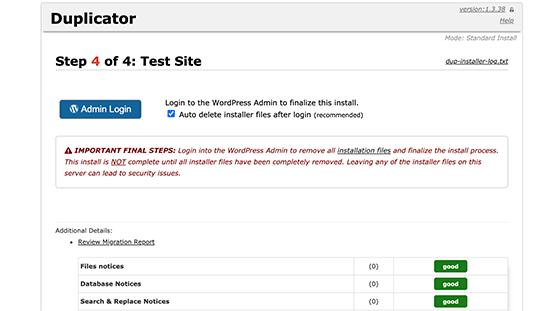
Das war’s. Sie haben Ihre Live-Site erfolgreich auf den lokalen Server verschoben.
Methode 2. Manuelles Verschieben einer Live-WordPress-Site auf einen lokalen Server
Sollte das Plugin bei Ihnen nicht funktionieren, können Sie Ihre Live-Site jederzeit manuell auf einen lokalen Server verschieben. Als Erstes müssen Sie Ihre Website manuell von Ihrem WordPress-Hosting-Konto aus sichern.
Schritt 1. Exportieren Sie die WordPress-Datenbank Ihrer Live-Site
Um die WordPress-Datenbank Ihrer Live-Site zu exportieren, müssen Sie sich in Ihrem cPanel-Dashboard anmelden und auf phpMyAdmin klicken.
Hinweis: Wir zeigen Screenshots vom Bluehost-Dashboard.
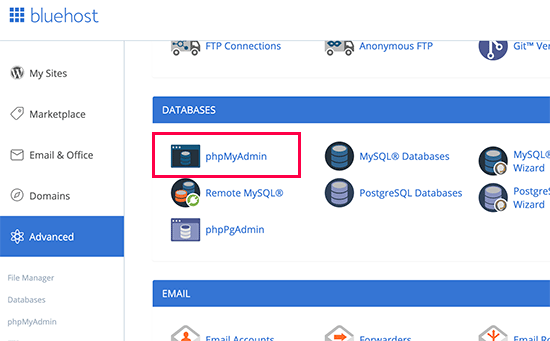
In phpMyAdmin müssen Sie die Datenbank auswählen, die Sie exportieren möchten, und dann oben auf die Registerkarte „Export“ klicken.
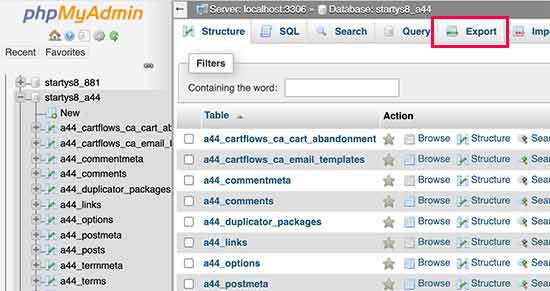
phpMyAdmin fordert Sie nun auf, entweder die schnelle oder die benutzerdefinierte Exportmethode zu wählen. Wir empfehlen, die benutzerdefinierte Methode zu verwenden und zip als Komprimierungsmethode zu wählen.
Manchmal können WordPress-Plugins ihre eigenen Tabellen in Ihrer WordPress-Datenbank erstellen. Wenn Sie dieses Plugin nicht mehr verwenden, können Sie mit der benutzerdefinierten Methode diese Tabellen ausschließen.
Lassen Sie die restlichen Optionen unverändert und klicken Sie auf die Schaltfläche „Go“, um Ihre Datenbanksicherung im Zip-Format herunterzuladen.
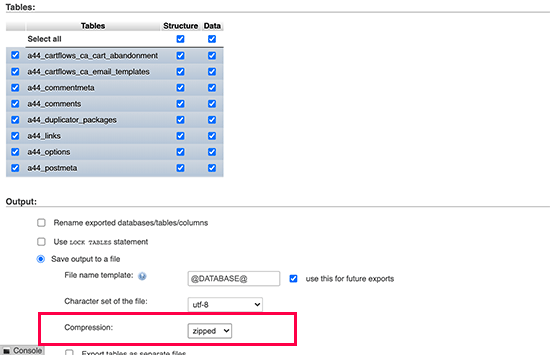
phpMyAdmin wird nun Ihre Datenbankdatei herunterladen. Weitere Details finden Sie in unserer Anleitung, wie Sie Ihre WordPress-Datenbank manuell sichern.
Schritt 2. Laden Sie alle Ihre WordPress-Dateien herunter
Der nächste Schritt besteht darin, Ihre WordPress-Dateien herunterzuladen. Dazu müssen Sie mit einem FTP-Client eine Verbindung zu Ihrer WordPress-Website herstellen.
Sobald die Verbindung hergestellt ist, wählen Sie alle Ihre WordPress-Dateien aus und laden Sie sie auf Ihren Computer herunter.
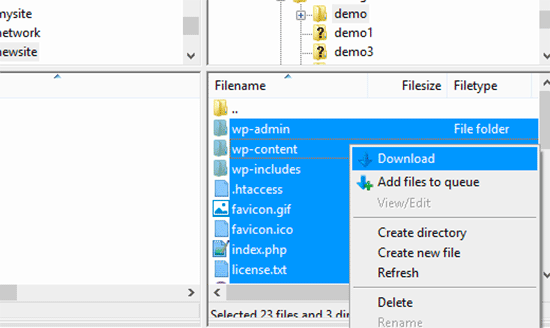
Schritt 3. Importieren Sie Ihre WordPress-Dateien und Datenbank auf den lokalen Server
Nachdem Sie Ihre WordPress-Dateien heruntergeladen haben, müssen Sie einen Ordner auf Ihrem lokalen Server erstellen, in den Sie die lokale Website importieren möchten.
Wenn Sie WAMP verwenden, sollten Sie einen Ordner im Ordner C:\wamp\www\ für Ihre lokale Website erstellen. MAMP-Benutzer müssen einen Ordner im Ordner /Applications/MAMP/htdocs/ erstellen.
Kopieren Sie anschließend einfach Ihre WordPress-Dateien und fügen Sie sie in den neuen Ordner ein.
Als nächstes müssen Sie Ihre WordPress-Datenbank importieren. Öffnen Sie einfach den phpMyAdmin auf Ihrem lokalen Server, indem Sie die folgende URL aufrufen:
http://localhost/phpmyadmin/
Da Sie die Datenbank bereits zuvor erstellt haben, müssen Sie sie nun auswählen und dann oben auf die Registerkarte „Importieren“ klicken.
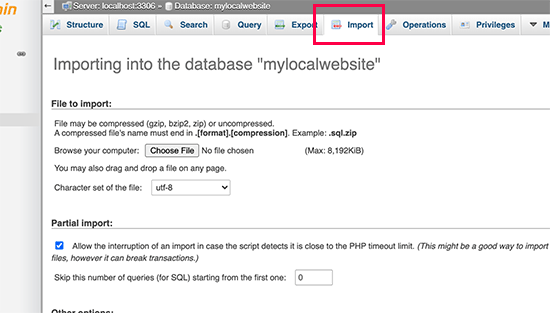
Klicken Sie auf die Schaltfläche „Datei auswählen“, um die im ersten Schritt heruntergeladene Datenbankexportdatei auszuwählen und hochzuladen. Klicken Sie anschließend auf die Schaltfläche „Go“ unten auf der Seite.
phpMyAdmin wird nun Ihre WordPress-Datenbank entpacken und importieren.
Nun, da Ihre Datenbank eingerichtet ist, müssen Sie die URLs innerhalb Ihrer WordPress-Datenbank aktualisieren, die auf Ihre Live-Site verweisen.
Sie können dies tun, indem Sie eine SQL-Abfrage in phpMyAdmin ausführen. Vergewissern Sie sich, dass Sie die Datenbank Ihrer lokalen Website ausgewählt haben, und klicken Sie dann auf SQL.
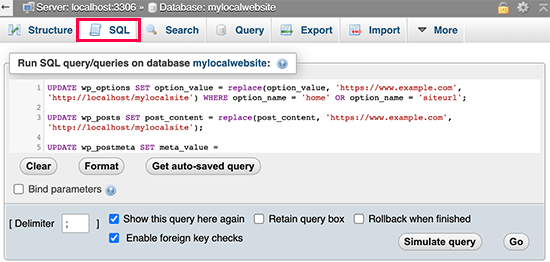
Kopieren Sie diesen Code in den SQL-Bildschirm von phpMyAdmin und fügen Sie ihn ein. Ersetzen Sie dabei example.com durch die URL Ihrer Live-Site und http://localhost/mylocalsite durch die lokale Server-URL Ihrer Site.
UPDATE wp_options SET option_value = replace(option_value, 'https://www.example.com', 'http://localhost/mylocalsite') WHERE option_name = 'home' OR option_name = 'siteurl'; UPDATE wp_posts SET post_content = replace(post_content, 'https://www.example.com', 'http://localhost/mylocalsite'); UPDATE wp_postmeta SET meta_value = replace(meta_value,'https://www.example.com','http://localhost/mylocalsite');
Diese Abfrage ersetzt Verweise auf die URL Ihrer Live-Site aus der Datenbank und ersetzt sie durch die URL des lokalen Hosts.
Schritt 4. Aktualisieren der Datei wp-config.php
Der letzte Schritt ist die Aktualisierung der Datei wp-config.php Ihrer lokalen Website. Diese Datei enthält WordPress-Einstellungen, einschließlich der Verbindung zu Ihrer WordPress-Datenbank.
Gehen Sie einfach zu dem Ordner, in dem Sie WordPress auf Ihrem lokalen Server installiert haben, und öffnen Sie die Datei wp-config.php in einem Texteditor wie Notepad.
Ersetzen Sie den Namen der Datenbank durch den Namen, den Sie in phpMyAdmin auf Ihrem localhost erstellt haben.
Danach ersetzen Sie den Datenbank-Benutzernamen durch Ihren lokalen MySQL-Benutzernamen, normalerweise ist das root. Wenn Sie ein Passwort für den MySQL-Benutzer root auf Ihrem localhost festgelegt haben, geben Sie dieses Passwort ein. Andernfalls lassen Sie es leer und speichern Sie Ihre Änderungen.
/** The name of the database for WordPress */
define('DB_NAME', 'database_name_here');
/** MySQL database username */
define('DB_USER', 'username_here');
/** MySQL database password */
define('DB_PASSWORD', 'password_here');
Sie können nun Ihre lokale Website in einem Browserfenster besuchen, indem Sie die URL wie folgt eingeben:
http://localhost/mylocalsite/
Ersetzen Sie „mylocalsite“ durch den Namen des Ordners, in den Sie Ihre WordPress-Dateien kopiert haben.
Das war’s. Ihre WordPress-Live-Site wird nun auf Ihren lokalen Server kopiert.
Wir hoffen, dass dieser Artikel Ihnen geholfen hat zu erfahren, wie Sie eine Live-WordPress-Site einfach auf einen lokalen Server verschieben können. Vielleicht interessiert Sie auch unsere Anleitung, wie Sie ganz einfach eine Staging-Site für WordPress zum Testen erstellen können, oder wie Sie eine WordPress-Site vom lokalen Server auf die Live-Site verschieben.
Wenn Ihnen dieser Artikel gefallen hat, dann abonnieren Sie bitte unseren YouTube-Kanal für WordPress-Videotutorials. Sie können uns auch auf Twitter und Facebook finden.





Reese
Hello,
I am receiving an error when reaching this step:
„Now that your database is all set up, you need to update the URLs inside your WordPress database referencing to your live site. You can do this by running an SQL query in phpMyAdmin. Make sure you have selected your local site’s database and then click on SQL. In phpMyAdmin’s SQL screen copy and paste this code, make sure that you replace example.com with your live site’s URL and localhost/test-site with the local server URL of your site. “
The error is:
#1146 – Table ‚rpd.wp_options‘ doesn’t exist
Please advise, thank you!
Martin
Thanks for all of your hard work. I’m a beginning web developer and your site is incredibly helpful.
I have looked at both of your articles about migrating from local to live and vice versa. I built a WordPress site locally and used it to replace an existing HTML site. I then made changes to the live site, and I’m not quite sure how to go about „syncing“ them again. What would you suggest?
WPBeginner Support
Hi Martin,
Please take a look at our guide on setting up a staging environment.
Admin
James
Thank you for the article, however i have still been having problems.
One thing i don’t understand, is that you start of by recommending using backupbuddy (which i have been using to backup my sites) but then suddenly say to use this duplicator plugin.
I have my full backup (with db) zip of my wordpress site which i created with backupbuddy and have unzipped it into its own folder in the „www“ folder in wamp.
I successfully create a new DB in PhpMyAdmin and then successfully imported my website db into it. I have also changed the config.php db name and password.
However on the next step, trying to change the urls it comes back with:
#1146 – Table ‚zexico.wp_options‘ doesn’t exist
#1146 – Table ‚zexico.wp_posts‘ doesn’t exist
#1146 – Table ‚zexico.wp_postmeta‘ doesn’t exist
What have i done wrong?
thank you
Ozi Diptongo
Hi. I’m getting the same error. Were you able to fix it ? Than you !
Nina Chang
Following on from my earlier comment – I fixed the problem! For some reason the duplicator plugin wasn’t copying across all of my database tables, which was causing the first round of issues – I sorted that by switching to the manual method. Then when I was running the queries in mysql I didn’t realise at first that I had to amend the names of the database tables as well (i.e. was just pasting wp_options when I needed to adapt that) – I’m not sure if this is normal as your lines of code only highlight the urls as needing to be corrected? THEN I had to deal with my strange wp-config.php file that had all the ‚database‘, ‚host‘, ‚username‘ fields already filled in – after trying both options it only worked when I deleted the data that wordpress had already filled in and replaced it with the localhost data as directed. I don’t understand why my wp-config file had its fields already populated but then I’m a complete newbie to all this so I’m bound to have missed/misunderstood lots. Anyway – thanks again for the tutorial as it did FINALLY get me there!
Nina Chang
Hi there,
Thanks for the tutorial. I’ve attempted to migrate my site with duplicator and it seems to work except I then can’t log-in to my locally hosted site – it doesn’t recognise my username at all. After the duplicator installed my files I had two config.php files – one config-sample.php and one config.php, and also two htaccess files – one .htaccess and one ORIG – could these doubled-up files have something to do with my login issues? I’ve tried every variation of deleting one of each pair, and I’ve also tried replacing my wp-login file and deleting plugins as I read elsewhere this might help, but nothing has worked. I redid the entire process from packaging and still no luck! I’ve also tried manually but got stuck at the mysql query updates. Do you have any idea where I’ve gone wrong??
Many thanks!
Nina
Susan Taunton
I can’t tell you how grateful I am for this info. I have put an unbelievable amount of time into trying to get a live site onto my local server to no avail — and then I found your post today. Used the Duplicator and it WORKED!
THANK YOU!!!!!!!!! :-))
Editorial Staff
You’re very welcome Susan
Admin
Dilip Pradhan
I have copied website from hosting domain to local host. everything is fine but all links of menu and all are redirected to
how to solve it
Byron Allen
hi ,
I had the same problem and just found the solution. I’m sure you’ve solved it by now but this might help others down the track.
in WordPress admin area go to settings-> permalinks. Choose Post name.
Your problems should be solved.
John Payne
Thanks for all the excellent advice you give- it’s a wonderful service to the WordPress community.
I’ve begun using the All-in-1 WP Migration plugin to easily backup my site , and later migrate it if necessary.
It would also be good to be able to make changes to the sites on my own computer, checking them out before uploading updated files.
I‘, installing XAMPP on my computer. Is there an easy way I can use my All-in-1 WP Migration backup files with this?
Any advice will be much appreciated.
WPBeginner Support
Hi John,
Sorry but we haven’t tested this plugin. Please try contacting the plugin developers.
Admin
Andres
Great tutorial. Its important to mention that you need to delete the HTACCESS File in order to this to work.
Thanks
James orr
From local site?
Siddhartha
Yes from the local site folder. I did that, and my site started working. However there are many other problems that I am facing even now. Like my category links are not working at all.
lohith
cool super clean tutorial, got mine to work without any issues.
Gokiko
Hi WPbeginner,
I have followed all the instructions for manual moving. But I’m getting a „Oops! That page can’t be found.“ error on the mainpage, none of the content can be viewed. And all the links in my localhost site direct to my online website.
It seems only the the main structure of my site(theme, menus etc.) has been moved but all the rest is lost.
WPBeginner Support
Is this error shown with your WordPress theme or on a blank white page? If it is shown on a blank white page, then this probably means that your WordPress site is not installed on the URL you are trying.
Admin
Gokiko
It shows on my WordPress theme. It also shows all my menus and content categories. But all the links take to the original websites address. Here is a screenshot if it’s gonna help:
WPBeginner Support
Try refreshing your site’s permalink structure. Go to Settings » Permalinks page and click on the save changes button without making any changes.
Juan
I have the exact same issue, but I can not log-in into my localhost using wp-admin or wp-login as it takes me to the live-site domain.
Is there another way to login to my localhost/dev-site area to make this change? thanks in advance!
Jason Hess
Dear WPBeginner,
First of all, Thank you for all you do in the WP community, my question is hopefully a pretty simple one. (Famous last words huh?) Currently I use CLEF to log in to my „Live Site“. When I move my Live site to my Local server, will this create any issues when attempting to log in to the local site once the move has been completed? Or do I need to create a new log in PW for my site via the Dashboard in my Live site before making the move to a Local environment or will CLEF still continue to work on my „Local Server“?
Also, do you all have any thoughts on using CLEF to log in? I’ve been using WP on and off for about 2 years and just want to get your opinion on CLEF.
Thank you very much in advance! You guys rock! After I get my site up and running you can bet I’ll promote your site to everyone I know. I’ve learned so much already from your site and I’ve only been a member for 2 almost 3 months now.
Have a great Day,
Jason Hess
WPBeginner Support
You can disable Clef at anytime once you have transferred your site to local server.
Admin
Mohd Amir
I forgot the password of filezilla, so I couldn’t download all the file of live site. I have backup of live site wp_content only. What can I do now for local server.
maarja
Hi,
Thank You for Your helpful directions.After a long while, I finally got the live page to my localhost with the plugin BUT for some reason, the content pages are not found on the server-all the information, texts etc is there in the back-office but aren’t shown in the front office except for the front page.
Do You have any idea where/why the problem might occur?
Thank You in advance,
Maarja
WPBeginner Support
Try following the steps in our beginner’s guide to troubleshooting WordPress errors.
Admin
Yellow Canary
Thank you very much I have done it manually… from a live server to localhost. With your instructions I have managed this for the first time. And I even know now how to do a SQL query in phpMyAdmin. I feel like a real pro!
I have done it manually… from a live server to localhost. With your instructions I have managed this for the first time. And I even know now how to do a SQL query in phpMyAdmin. I feel like a real pro!
amna
Hi,
i followed all the steps but i am getting internal server error .
I am confused in one step , after downloading the live site through filezill from godaddy host. i replace the wordpress folder with my live site folder i.e.
C:/users/amna/wamp/www/wordpress/old folders
with C:/users/amna/wamp/www/wordpress/mywebsite new folders
please help i am a beginner
Debenkumar Naorem
Hi WEBBIGINNER SUPPORT, I followed the instruction for manual, it works very fine. Thanks for such intructions, I’ve been looking for this. Thanks again.
WPBeginner Support
Hey Debenkumar, you are welcome. Don’t forget to join us Facebook for more WordPress tips and tutorials.
Admin
Manish
Hey! Thanks for the post.
I followed manual instruction and replaced my site URL with localhost/name of blog . The problem I am facing is, no images are being loaded in my blog. All the uploaded images are there in upload folder. The text is absolutely fine. The images url have changed to localhost but they are not showing up.
Could you please help me out in this?
deepthi
hi, i followed the manual procedure to check my wordpress website in localhost using xampp, i hav changed the site URL, home and the wp-posts and wp-postmeta. the problem is my home page loading fine in localhost. but when i go the pages in the menu the following error is coming.
Object not found!
The requested URL was not found on this server. The link on the referring page seems to be wrong or outdated. Please inform the author of that page about the error.
If you think this is a server error, please contact the webmaster.
Error 404
localhost
Apache/2.4.10 (Win32) OpenSSL/1.0.1i PHP/5.5.15
i logged into dashboard and can see all of the page content in the editing section, but from there also, when i try to view the page its reporting the same error.
the url path it is taking is my updatedURL only,
please reply with the solution
WPBeginner Support
Go to Settings » Permalinks page and click on the ‚Save Changes‘ button to update your permalinks.
Admin
Joshua S.
Can I hug you? Can I love you forever?
I was having the same issue. I did everything correct, except the homepage would load , but all the other page links seemed to be broken (it just displayed an unstyled layout of my localhost information).
But going into Settings>Permalinks>Save Changes reset my links and now I can access my different pages, even the new pages that I create since moving my site to the local host.
LIKE!
WPBeginner Support
Thanks Joshua, we are glad you found it helpful. You may also want to subscribe to our YouTube Channel for WordPress video tutorials.
Peter
After following the instructions to manually move the site, the home page displayed fine on localhost but none of the links worked. The page below said to „Go to settings/permalinks in the wordpress dashboard and update permalinks by clicking twice on save changes.“ That fixed it.
Mohd Hasan
I followed your steps , but only home page works fine and none of the links are working . Give The requested URL /akhdir3/category/health/ was not found on this server.
Anes P A
Dear Author,
I tried your step. But problem is when loading a page the localhost refer online site and the Menu links point to the online web site. How it can solve ?
Please advise.
Thanks
Anes
Bhavana
I have manually done all the above mentioned steps . But I am not getting the actual site which I want.There comes all uninstalled plugins in admin panel and the theme is also uncustomized. Where I am going wrong?
Justin
I’m trying to follow your instructions for a manual move.
When trying to find/replace the live site’s address with my local host, SQL tells me there’s a syntax error.
#1064 – You have an error in your SQL syntax; check the manual that corresponds to your MariaDB server version for the right syntax to use near ‚)‘ at line 1
Are you sure the code is correct?
Justin
Fixed my own problem….sort of.
For some reason all my tables begin with wplm instead of just wp (wp_options = wplm_options for example). So updating the code to look for the correct table name allowed the script to run without errors.
But….SQL reports “# MySQL returned an empty result set (i.e. zero rows)” and the values in the table didn’t get updated. I had to go in and update the links by hand. In my case this was only 2 values in wplm_options, but I could imagine some people will have a lot more links to check.
Still, I do have my site imported now, and dealing with local hosting is a notoriously confusing process.
Thanks for the clear and simple instructions!
Lloyd
The instructions for Duplicaor Installer begin with this line:
„Your local server site will need a new database, so you need to create a database on your local server using phpMyAdmin.“
Is creating a new database something simple like clicking a menu option, or is it so complex that it would require an extensive tutorial to explain?
When I explore phpMyAdmin on Xampp, the only thing I see that looks like a possibility is under the Databases tab where it says:
„Create database:
(X) No Privileges“
Is there an authorization problem, and if so where do I go to change that parameter?
I have two web sites on this local host that seem to function properly, so I have assumed that the local host is set up correctly.
Thanks for any help or suggestions,
Lloyd
Ashvani Kumar
I am following the Manual option but when i go to Import Database page in phpMyAdmin then the max size for database upload is (Max: 2,048KiB) but my database backup size is 710MB. How do i increase this limit so that i can upload the database?
Thanks
WPBeginner Support
You need to increase the file upload limit in PHP. See our guide on how to increase the maximum file upload size. and follow the php.ini method
Admin
Abdul Aleem Mohammed
Hi Ashvani,
you can change the max_upload_size in php.ini file in apache.
by default it will be 2 Mb, you can change it according to your convinience.
Thanks
Judy Williams
I am trying this using Duplicator. I have downloaded my site and the installer. I have created a database using phpMyAdmin and have got to the bit ‚you need to copy and paste the package and install file to an empty folder in your local server’s web directory‘. I have no idea how to do this! I have Filezilla and XAMPP installed on my laptop. Is there a tutorial on how to create an empty folder in my local server’s web directory? I am stuck now. Thanks
WPBeginner Support
You can just go to the htdocs folder on your computer.
Admin
german
I’ve copied the files and database, when i try to access my localhost/test-site i get redirected to the dashboard. Any ideas why this could be happening?
miguel
thank you for the clear tutorial.
although i’ve done the opposite (from localhost to public server) i thought the reverse would be equally simple.
however, when it comes to connecting the database, i’m stumped. i’ve gone over the settings over and over without being able to connect.
i even got into some trouble and got locked out of the database but fortunately got that resolved.
in my config.php file i’ve changed the user to „root“, then set it to empty, used the user name from the public server and the same with the password. i have set the db name correctly to the localhost name.
i can’t guess what i need to do.
if you could give me a direction to look next, i’ll appreciate it greatly.
thank you for you labor of love. it’s great to see so many people with the knowledge helping us those who look for answers.
Daniel
Hi
I want to do this as well. Is this post written a few years back , still the approach to use or are the other plugins or post I should be looking at .
Daniel
Beatrix K.
Hi everyone,
Just wondering (please bare with me as I am new at this) – if I need to have have my local site to work with on two different devices, say my desktop and my laptop, is there a way for the changes I make on one device to be updated on the other device? I just want to know if it is possible to work from two different devices on the same project and not have to redo all of my changes. Thanks in advance for any insight
B
Muniba
I am confused in step related to Filezeila ,,, how i will download my wordpress site using Filezeila..??
german
download filezilla, establish a connection to your current host, productions site using filezilla. Once you have a connection you will be able to download the files to a local directory on your computer
Dee
So with CPanel, for instance, we’d use the IP associated, our CPanel user and pass, along with „21“ as the port value? After establishing a connection with Cpanel host, how can I transfer the files to my localhost while keeping the live site as well? Essentially, how do I create a duplicate with having the same site at both hosts (one to experiment with and one that remains live)?
Dee
After successfully transferring files from remote to local, what is an easy way to bulk copy&paste (instead of manually one-by-one) the files to the local server where we want to install WordPress? I tried selecting all files to copy, but there is no copy function available. Please Help
assal0le
I want to copy my live wordpress site to my local wamp server, note moving it. My question is this will remove my live wordpress site if I follow this tutorial using duplicator plugin?
Thx
Diane Laidlaw
No it only copies it.
Ognatius Chironga
I thank you so much!
I found this article helpful.
I almost restarted creating my site.
Quy P
I have tested and tried a number of time. It does not work untill i delete the .htaccess file on local. Thank you.
Andres
Thanks very much.
Tobias
If you are running a network of sites you should also update the column domain URL’s in the table wp_blogs.
lorenzo
Thank for this useful tutorial. I have to move manually my wp site, but if I type in the browser „http://localhost/phpmyadmin/“ it doesn’t appear myphpadmin. Maybe I have to install it? How?
Thank you very much…
Dave
In the wp-config.php file I also have to change the /**MySQL hostname */
/** MySQL hostname */
define(‚DB_HOST‘, ‚localhost‘);
set if for localhost
nicola
Hi,
i follow your step but the admin login is not visible…. error 404 not found. all the site is good in my local installation. how can i solve my problem?
abdelouahad
i did all the steps but i have always the error page i don’t know why some one can help me please
Paul Denver Sy
Thank you so much for this. It saved my almost a week of agony on running it on my local.
Shilling
Double checked all the steps and it all seems good, but I’m getting this error message when I go to the site on my local URL:
Google Chrome’s connection attempt to localhost was rejected. The website may be down, or your network may not be properly configured.
I don’t think the site is down. My local URL is auto flipping to http://localhost/wordpress-folder-name
when I think it should go to http://localhost:888/wordpress-folder-name
I’m hoping this is an obvious clue. I’m new at this and just have no idea.
Any insight would be much appreciated.
Ebert
This was the clearest tutorial I found which helped me to copy a site I started with iPage to my laptop under localhost. The database was not imported but created a new local copy of the server database. I copied the data tables into my new database and modified the sql commands to match the table names and everything ran smoothly.
I had to reuse the password I used on the live site with the local wordpress copy and I can now access and modify what I need to.
Thanks and you just got another new subscriber to this great site.
Also the post about BackWPup was very helpful as well. I tried to use Duplicator and it kept giving me error messages about permissions to create a backup folder on my machine. I used BackWPup and everything ran without a hitch. Thanks again!!
Eduardo Weidman Barijan
The manual process worked like a charm. Thank you.
Alessio
Hi guys,
I’m trying to config the localhost on my computer with linux mint.
i’ve already set up a new database, transferred the files with FTP to my local wordpress folder.
Now I imported the db, but when I give the query to change the webaddress with a local address, it will give me a message „# MySQL returned an empty result set (i.e. zero rows)“.
Now, if I type in the browser „localhost“, it will lead me to the online website…
what should I do?
thank you!
idriss
Hey Allesio,
Did you manage to solve this?
I have the same issue. How did you manage to solve it?
Thanks
Justin
Same problem here.
SQL is having trouble replacing the live site URL with the local host address.
Without the updates to the database, WP tries to connect to the live site instead of the local site.
Did either of you have any luck fixing this?
Sam
Go to your localhost phpmyadmin and the database you are using for the site. Click wp_options and edit the siteurl and home. Replace the live url with the: localhost/ your-folder-name-goes-here
That should do it.
Sam
Mike
The first step worked with me.
But how can I enter to localhost/test-site/wp-admin? It gives me an error message:
Internal Server Error
Wenke Adam
Updating the local site’s wp-config.php file might not be the last step in this procedure. I followed your instructions and after some trials the public site was working (first I had a typo in the SQL queries and nothing happened) but still I couldn’t access wp-admin.
The solution was to edit the wp_options table in the database. The first row had the wrong URL. I fixed this and finally everything was working fine, even the permalinks.
Thanks for all these very nice and clear tutorials!
Tim
I am reposting this because it seems to have disappeared (at least on my end). So I am sorry if it is a double post.
I am getting an error message when uploading the database. Any ideas?
Thanks
Tim
When I try to upload the database I get a Red Error Screen. I can send a screenshot of the error if you would like.
Thanks
WPBeginner Support
Sure, you can upload the screenshot to a cloud hosting service like dropbox and paste the link as a reply to this comment. We will then take a look and will try to help.
Admin
Ian Hyndman
All day I have been trying to do this change with no effect !
I even had to install word press again on my testing server. Was about to give up then I came across this. My other option was to manually copy and paste and install all the same plugins active on my host server to my testing server.
When i read your post i finished in 5 minutes :):)
Thank you for your tutorial, its just what I needed. !
Well Done
Alexandros
Two days i am trying to do this change alone with no effect !
When i read your post i finished in 5 minutes :):)
Thank you for everything !
Keep up the great work